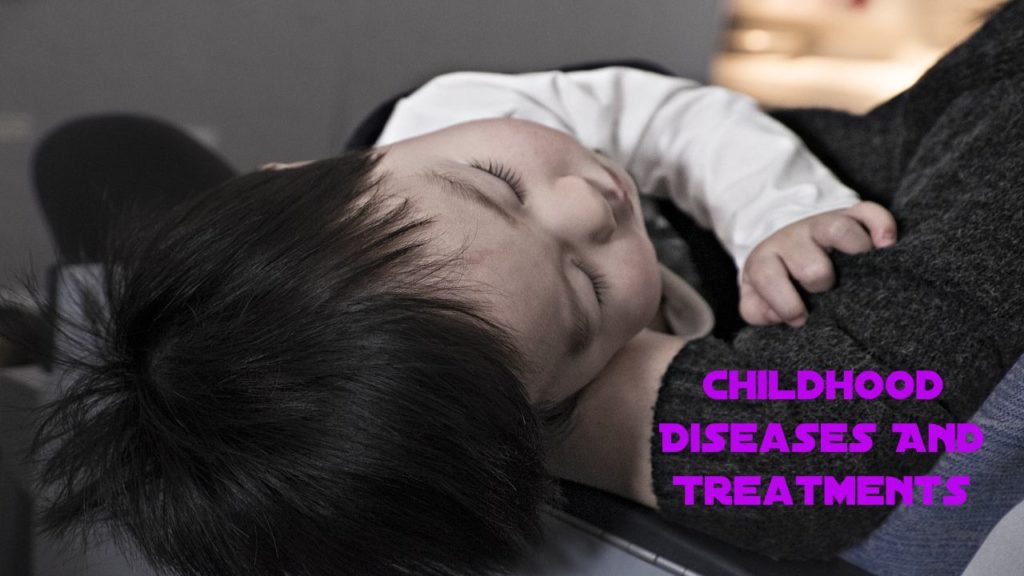All children deserve high-quality medical care.
As parents, it is important to be aware of the latest treatment guidelines to be sure.
Our children receive the best possible care.
Many childhood diseases and treatments have approved.
The treatment base on diseases and will continue the best practice.
However, your pediatrician may have reasons to offer different recommendations.
Especially whose child has a medical condition is not good or suffers from an allergy.
If you have any questions about the most appropriate care for your child, talk to your pediatrician about it.

Top 10 Childhood Diseases And Treatments
-
-
Sore Throat
-
Sore throats are common in children, and it can be painful.
However, a sore throat caused by a virus does not require antibiotics.
In those cases, no specific medication needs, and your child will feel better in seven to ten days.
In other cases, a sore throat could cause a strep infection (pharyngitis).
Pharyngitis cannot be accurately diagnosed simply by looking at the throat.
A laboratory examination, including a quick throat swab, is needed to confirm the diagnosis of pharyngitis.
If the pharyngitis test result is positive, the pediatrician will prescribe an antibiotic.
Your child must take the antibiotic throughout the treatment, as directed, even if the symptoms improve or disappear.
Steroid medications (such as prednisone) are not an appropriate treatment in most cases of sore throat.
Babies and young children rarely have pharyngitis.
But they are more prone to infections caused by the strep bacteria.
If they go to daycare or if an older brother has the disease.
Although pharyngitis mainly spread by coughing and sneezing.
-
Earache
Earache is common in children and can have many causes, among others.
- Ear infection (otitis media)
- Swimmer’s ear (skin infection in the ear canal)
- Pressure due to a cold or sinus infection
- Pain in the teeth that radiates from the jaw to the ear, etc.
To differentiate them, the pediatrician will need to examine your child’s ear.
An office exam is still the best way for your pediatrician to make an accurate diagnosis.
Your child suffers from earache by a high fever; it affects both ears.
Your child has other symptoms of illness; the pediatrician may decide that an antibiotic treatment.
Amoxicillin is the better antibiotic for middle ear infections, except in cases of penicillin allergy or chronic or recurrent infections.
Many true ear infections cause by viruses and do not require antibiotics.
The pediatrician suspects that a virus may cause your child’s ear infection.
-
Urinary Tract Infection Is a Common Childhood Diseases
UTIs occur bacteria build up in the urinary tract.
UTIs can occur in children from infancy to adolescence and into adulthood.
Symptoms of a urinary tract infection include, but are not limited to,
- Pain or burning while urinating
- Frequent or urgent need to urinate
- Bedwetting or
- Accidents in children.
Who has already left diapers, abdominal pain, or pain in the side of the back?
Your doctor will send a urine sample to test for urinary tract infection before determining treatment.
Your doctor can tailor treatment based on the bacteria found in your child’s urine.
-
Skin Infection
For most children with skin infections, a skin test (culture or swab) may need to determine the most appropriate treatment.
-
Bronchitis
Bronchitis is an infection of the larger central airways in the lungs and is seen more often in adults.
The word “bronchitis” commonly uses to describe a virus in the chest that does not need.
-
Bronchiolitis Common Childhood Diseases
Bronchiolitis is a common infection during the cold and flu season.
The doctor may hear “wheezing” when your child breathes.
Bronchiolitis usually causes by a virus that does not need antibiotics.
Instead, most recommendations for treatment focus on making your child comfortable with close monitoring.
A difficulty to take breathing and eating.
Children who are premature or have underlying health problems may need different treatments.
-
Pain
The best medications for pain relief in children are acetaminophen or ibuprofen.
Talk to your pediatrician to determine the amount of baby pain relief medicine dose you should give your child; this should base on the child’s weight.
Narcotic pain relievers are not appropriate for children with common injuries or ailments, such as:
- An ankle sprain
- Earache or
- Sore throat.
Codeine should never be given to children as this drug has associated with severe respiratory problems, even death in children.
-
Common Cold
Viruses in the upper respiratory tract cause colds.
Many young children, especially those who go to daycare, can have 6 to 8 colds a year.
Symptoms as a runny nose, congestion, and cough can last for ten days.
Green mucus in the nose does not mean that antibiotics are needed.
Antibiotics are not necessary to treat the common cold.
Antibiotics are a good option based on your child’s symptoms and the result of a physical exam.
-
Bacterial Sinusitis
Bacterial sinusitis causes by bacteria trapped in the sinuses.
Sinusitis is suspected when cold symptoms, such as a runny nose, daytime cough, or both.
Antibiotics may be necessary if this condition also has a
- Thick
- Yellow runny nose
- Fever
-
Cough
Cough medicine is not recommended for children four years of age.
Younger or children 4-6 years of age unless directed by your doctor.
Studies have consistently shown that cough medications don’t work in the age group of 4 years and younger.
It can cause serious side effects.
Cough medicines with narcotics such as codeine should not give to children.

